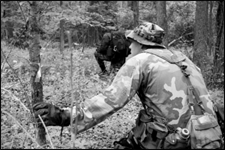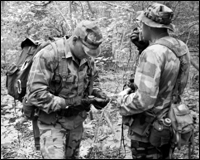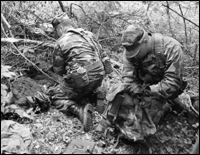 It's 3:30 on a cold and wet Sunday morning.
You are crouched in a field across from a
clandestine marijuana field. Your mission:
observe any vehicles entering or leaving the
field via the access road and report back to the local law
enforcement officer.
It's 3:30 on a cold and wet Sunday morning.
You are crouched in a field across from a
clandestine marijuana field. Your mission:
observe any vehicles entering or leaving the
field via the access road and report back to the local law
enforcement officer.
Who are you? You are one of a select few members of the New Jersey National Guard who perform reconnaissance and eradication missions for the CounterDrug Task Force (CDTF). According to 1st Sgt. Keith Stokley, CDTF NCOIC, the five-member group consists of combat arms personnel who are proficient in land navigation, familiar with all aspects of the marijuana trade, and have a working knowledge of tactical reconnaissance equipment as well as the art of observing and evading detection.
Although the team could use a few more members, it is tough to find personnel who fit the qualifications. In addition, they must live in south central New Jersey and be available and willing to work the often times odd hours that are dictated by the criminals. Even then, getting on the team isn't guaranteed.
 "We look at each prospective member and ask ourselves, 'What can this person
bring to the team,'" explained
1st Sgt. Stokley. Although the
team is not limited strictly to
infantry types, the soldiers must
have something to offer. For
example, as part of their mission, the team trains law en-
forcement personnel in land
navigation and reconnaissance
equipment and techniques,
which might be unfamiliar to
the police officer. Some members of the team also travel
outside the state to instruct law
enforcement personnel at locations such as at the National
Guard CounterDrug Regional Training Center at Fort
Indiantown Gap, PA.
"We look at each prospective member and ask ourselves, 'What can this person
bring to the team,'" explained
1st Sgt. Stokley. Although the
team is not limited strictly to
infantry types, the soldiers must
have something to offer. For
example, as part of their mission, the team trains law en-
forcement personnel in land
navigation and reconnaissance
equipment and techniques,
which might be unfamiliar to
the police officer. Some members of the team also travel
outside the state to instruct law
enforcement personnel at locations such as at the National
Guard CounterDrug Regional Training Center at Fort
Indiantown Gap, PA.
The CDTF team has been around in one form or another since the beginning of the last decade. The team's current configuration began operations in the summer of 1994 as a combined effort with the State Police to conduct a one-week class on marijuana eradication at Fort Dix. Thirteen law enforcement officers from around the state attended the training. In 1995, the class was moved to Sea Girt as a three-day seminar and has averaged 80 students per class ever since.
The team's first real mission took place in August of 1994, and resulted in the seizure of approximately 130 marijuana plants and two arrests. The numbers of arrests have increased and average 18 per year. "The arrest rate helps define the team's success, as the intent is not only to eliminate the plants, but also to stop the persons responsible," according to 1st Sgt. Stokley. Summer is always a busy time; missions constantly overlap and the team is usually stretched to its capacity.
Recent changes in the New Jersey statutes have highlighted the importance of the eradication team. In August 1997, possession of 50 marijuana plants outdoors and/or 10 marijuana plants indoors was a first-degree felony.
 Contrary to what one might imagine, not all missions
are full of excitement. Many times, reconnaissance
teams will lie in wait for hours, only to find out that the
target never showed up or used a different route to the
field. Once in a while though, complications arise which
increase the adrenaline level. "There have been a few
instances where the team has come across a field which
has been rigged with rudimentary booby traps, such as
fish hooks dangling from trees at eye level or some type
of punji stick embedded in the ground," noted Stokley.
"Aside from some bumps, bruises, scrapes, sunburn,
and insect bites, so far no one, Guard or law enforcement
officer, has been seriously hurt."
Contrary to what one might imagine, not all missions
are full of excitement. Many times, reconnaissance
teams will lie in wait for hours, only to find out that the
target never showed up or used a different route to the
field. Once in a while though, complications arise which
increase the adrenaline level. "There have been a few
instances where the team has come across a field which
has been rigged with rudimentary booby traps, such as
fish hooks dangling from trees at eye level or some type
of punji stick embedded in the ground," noted Stokley.
"Aside from some bumps, bruises, scrapes, sunburn,
and insect bites, so far no one, Guard or law enforcement
officer, has been seriously hurt."
Although the team has been involved in a few close calls over the past few years, safety is the primary concern whenever the task force prepares for a mission. In addition, strict rules regarding what can or cannot be done by National Guard personnel are always covered in the operations plan. Situations such as the handling of weapons or evidence by CDTF personnel are strictly prohibited as per the guidelines set up by the National Guard Bureau. Finally, every time the team goes on a mission, law enforcement personnel, who ensure that the mission is accomplished with a minimum of risk, always accompany them.
"It's always a continuous learning process," commented Stokely. To illustrate the point, the team was sitting down to a class in map reading. The team seldom utilizes military maps because of their lack of availability. Stokley was able to obtain 1:24,000 topographic maps that cover the whole state. The 1:24,000 scale is more than twice the size of the 1:50,000 military map, providing much greater graphic detail, making it easier to plot and navigate.
Back in the field, a pickup truck pulls up, the driver gets out and walks in to the field. The CDTF team members radio the law enforcement officials and the driver is arrested. 168 plants are seized and the grower dimed out the other criminals.
Not bad for a day's work.